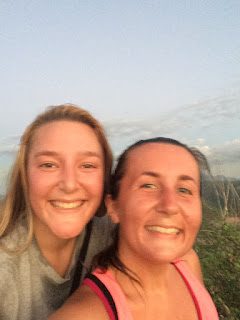A few weeks back, Stephanie (she’s amazing and shares our office) took us on an adventure to sea turtle camp. We visited ASUPMATOMA in Playa San Cristobal where they do amazing work with sea turtles. When we visited, they were preparing for the 5th annual sea turtle festival which was taking place on Sunday the 8th of November. Stephanie told us that we’d be able to release baby sea turtles but I didn’t realize how incredible of an experience we’d be having on the beach that night. Just after arriving at turtle camp, Stephanie walked up to us carrying a green bucket which was full of baby sea turtles. They were so cute!!!



During an incredible sunset, we were able to release between 70 and 80 baby Olive Ridley turtles. As the sun was coming down, we set the little guys on the beach a bit back from the waves so they could scurry to the sea. The reason behind letting them go on the beach and not directly in the water has to do with how they return to the same beach to nest themselves 10 years later. We made sure everyone made it to the sea and no one was trapped in the waves or surge on the beach.
After releasing the hatchlings and wishing them well with encouragement, we set off to the corrals on site where most of the nests are located. Stephanie told us about how the nests are moved from their original locations so that the eggs can be protected from poachers, wild animals and happenings on the beach. Each nest is marked with an identification number, the number of eggs and the date that the nest is supposed to hatch. That night, turtles were starting to come out of one of the nests and we were able to see the hatchlings emerge from the sand. We counted the hatchlings and then helped dig out some of the sand to free the hatchlings that might not have been able to get to surface themselves (it’s tough work being a baby turtle!!!). We also removed the egg shells and helped with taking data on the nest. We were able to release these babies that very night with happy birthdays as they ventured to the ocean.

The next morning we woke up early and went out to the corrals to check on any nests that were expected to hatch. There were four or five with turtles that had come out of the sand. We helped count the turtles and eggs while checking to see if any insect larva had predated the eggs. Unfortunately, not all of the turtles hatch or survive so the other part of digging out the nests is to count the hatchlings that haven’t made it and the eggs that are still intact. Every aspect of helping with the sea turtle nests was incredible even when it came to those who weren’t lucky enough to make it out of the nest. When the hatchlings come out of the sand in the morning, they give the turtles time to rest throughout the day then release them to the sea at sunset. That night, they were having a special release of a few hundred turtles that were hatching throughout the day.
We got involved in the turtle festival by helping prepare arts and crafts and then playing some volleyball on the beach. After beach volleyball, Ashley, Stephanie and I wandered around with a frame for the turtle camp and encouraged people to have their photo taken in the “photobooth”.
The staff and volunteers at turtle camp did amazing work throughout the day hosting arts and crafts, face painting, videos, hikes and all sorts of activities. A group of students from a local university were also there helping out and providing information. The event is a great fundraiser for the camp and people are excited to be able to visit the camp and the incredible beach where the camp is located. We left before sunset but I’m sure that those who were there for the turtle release that night got to experience the same magic that we had witnessed the previous evening. It was one of the best experiences I’ve ever had releasing those babies to the sea and wishing them the best of luck on their adventures.
Once we left turtle camp, we started our adventure back to La Paz. We stopped at Playa Los Cerritos (see post about Todos Santos) and went for a swim in the waves. We then returned to La Paz, our hearts full with baby turtles and our cameras full of photos. Darren had to listen to us talk about the baby turtles for about a week. Much thanks to Stephanie and the staff at turtle camp for such an awesome weekend!
Nicole
































